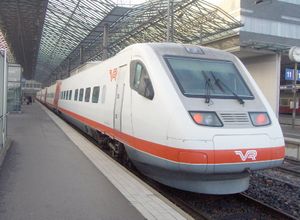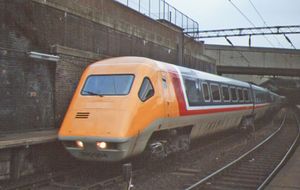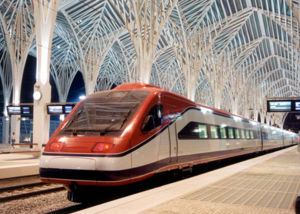Pendolino
Pendolino (from Italian Pendolo "Pendulum" and -ino, a diminutive suffix) is an Italian family of tilting trains used in Italy, Spain, Portugal, Slovenia, Finland, the Czech Republic, United Kingdom and Switzerland. It was developed and manufactured by Fiat Ferroviaria, which was taken over by Alstom in 2002.
The idea of a tilting train became popular in the 1960s and 1970s when various rail operators, impressed by the high-speed rail services being put into place in France and Japan, wondered how they could similarly speed up travel without building a dedicated parallel rail network (as those two countries were doing). By tilting, the train could round curves designed for slower trains at higher speeds without causing undue discomfort to passengers.
Contents
Italy
In Italy various possibilities along these lines were explored (including one early design for fixed carriages with tilting seats). A number of prototypes were built and tested, and in 1975 a prototype Pendolino, the ETR 401, was put into public service, built by Fiat and operated by Italian State Railways. In 1987 operation began by a full fleet of updated Pendolinos (called the ETR 450), which incorporated some technologies from British Rail's ill-fated APT project. In 1993 the next generation, the ETR 460, began service.
Finland

The Finnish model, the S220, is based on the ETR 460, adapted to the specific requirements of VR ( Valtionrautatiet, Finnish State Railways) and to the cold climatic conditions. The first two units were made in 1995 by Rautaruukki-Transtech, a rolling stock company now part of Spanish Talgo.
The Pendolino has been conceived as an EMU (Electric Multiple Unit) to keep axle load to an extremely low level in order to allow the train to negotiate curves at a speed higher by up to 35% if compared with conventional Intercity trains (loco plus coaches).
The electrical traction equipment, with continuous power of 4000 kW, includes GTO chopper/inverter and asynchronous motors. The tilting system in the bogie, located entirely under the body, has permitted the reorganisation of the vestibules and passenger compartment areas. The bogie-to-body connection is extremely simple and easy to make, with clear advantages for maintenance.
The body, which exploits large aluminium extrusion technology, has substantial modularity and allows for extremely low axle weight, whilst fully respecting the highest safety standards, and allows the best exploitation of the space with different loading gauges.
The trains for VR are composed of 6 vehicles: two traction units, each unit consists of two motor poop/converter with four traction motors (one for each bogie), plus a trailer coach with high voltage equipment (25 kV and 50 Hz) and traction transformer, and two end coaches with aerodynamic driving cab; one of the trailer coaches (TTC) has a special featured bar section.
United Kingdom
In 2004 Virgin Trains in the UK began operating custom-designed Pendolino trains known as the Class 390 on its West Coast Main Line (WCML) franchise.
These trains were constructed by Alstom and are leased by Virgin Trains from Angel Trains.
Due to the failure of the WCML upgrade to provide in-cab signalling these units are limited in service to 125 mph (200 km/h) operation rather than their 140 mph (225 km/h) design speed. Virgin Trains are currently examining running these at 135 mph through the Trent Valley as part of their new WCML Franchise Proposal.
The Class 390 Pendolino are maintained by Alstom (West Coast Traincare) under contract to Virgin Trains until 2012. The main maintenance locations are Wembley, Midlands (Oxley, Wolverhampton), Manchester (Longsight), Glasgow (Polmadie), and Liverpool (Minor work only) and several "Traincare Points" along the line of route (such as Euston and Carlisle). Headquarters for West Coast Traincare moved from the former Metro-Cammell factory at Washwood Heath in Birmingham upon its closure in November 2005 to Manchester Longsight depot with some functions being based at a new office facility at Oxley depot.
Virgin Trains have proposed the addition of a tenth (and possibly eleventh) car to the nine-car Class 390 trains in the near future to increase passenger capacity.
Two decades earlier British Rail had planned to bring tilting train technology to the same line with the APT project. Technical problems and lack of the political will to overcome them forced the abandonment of this early attempt, although much of the technology was used to design and build Pendolino trains.
Virgin Trains accident - 23 February 2007
One dead in Cumbria train crash
An elderly woman has died and five other passengers have been seriously hurt in a train derailment in Cumbria.
Several carriages were left on their side after a Virgin London to Glasgow service crashed at Grayrigg, near Kendal, at 2015 GMT, at about 95mph.
Police said 22 people went to hospital and dozens more were "walking wounded".
Investigators say no cause has yet been established, but rail union chief Bob Crow said he had been told the accident was due to a points failure.
The train involved in Friday's train crash in Cumbria is a Pendolino tilting train - capable of running at up to 125mph (200km/h) on the West Coast Main Line.
Running between London and Glasgow, the £11m trains cover the route in around four-and-a-half hours.
The trains, built in Birmingham, were first introduced by Virgin in July 2002. The firm now operates more than 50 Pendolinos.
The trains had a top speed of 110mph (177km/h) until December 2005, when an upgrade of the West Coast Main Line was completed.
Source: BBC News <googlemap lat="54.356556" lon="-2.664657" zoom="14" width="400" height="400" controls="large"> 54.356031, -2.664871, see the preliminary report for accurate map of crash site </googlemap>
Grayrigg RAIB prelimary report
Portugal
In Portugal the Pendolino is named Alfa Pendular and is operated by the Portuguese state railway company CP. It connects the cities of Braga, Porto, Aveiro, Coimbra, Santarém, Lisbon, Albufeira and Faro, among others, and has a top speed of 220 km/h (136.7 mph). The bogies had to be redesigned for operation on Portugal's broad gauge track, and the trains were assembled by Alstom at the Portuguese Amadora plant.
Slovenia
Slovenian Railways operates a Pendolino tilting train similar to the Italian model on its main lines. The ICS links the major cities of Slovenia in one line: Koper (only in summer), Ljubljana, Zidani Most, Celje and Maribor, with a frequent service that acts as a high-speed shuttle. For further information, see InterCitySlovenija.
Czech Republic
In 2000 Fiat Ferroviaria undertook an order of construction of Czech tilting train and changed it to Pendolino. The first set was delivered in 2004 as Pendolino CD 680. While testing from Břeclav to Brno on November 18, 2004, the Pendolino reached a speed of 237 km/h and created a new Czech railway speed record.
The train was featured in the 2006 James Bond film Casino Royale. Whilst in reality the Czech Pendolino does not actually operate the route, in the movie it was shown to journey from Switzerland to Montenegro.

During the testing period, the train had problems with the Czech signalling system. The problems were said to be solved and the trains entered regular service in December 2005 between Prague and Ostrava. As of late January 2006, all five Czech Pendolino trains that had been put in service suffer from software and functional problems. (The other two of the seven trains have never entered service.) The range of problems is spanning from failing airconditioning and heating to failures of the tilting control. The supposedly ERTMS compliant control system ATLAS is not able to properly join several discrete systems each based on different software platforms. Similar problems have also been reported from Finland. Czech Railways has demanded that Alstom corrects the problems by the end of January 2006 and commissioned audit of the tendering and contracting process. Czech ministry of transportation has threatened the contract will be cancelled and the trains returned if problems are not resolved.
The future
Currently, a number of countries in Central and Eastern Europe have ordered Pendolino trainsets, including Poland and possibly Romania. For this reason, the Pendolino-type train is set to be the one with the greatest penetration in the high-speed market of Central and Eastern Europe.
Technical information (Finnish trains)
- Maximum speed: 220 km/h
- Power: 4,000 kW
- Traction motors: 8 asynchronous three-phase AC
- Acceleration, 0 - 100 km/h: 57 s, 810 m (a=0.50 m/s2)
- Acceleration, 0 - 200 km/h: 193 s, 6,800 m (a=0.37 m/s2)
- Braking, 140 - 0 km/h: 750 m (a=1.01 m/s2)
- Braking, 200 - 0 km/h: 1,650 m (a=0.94 m/s2)
- Tractive effort at rims: 163 kN
- Length: 158.9 m
- Width: 3.2 m
- Height: 3.73 m
- Weight: 328 t (originally 316 t)
- Maximum axle load: 14.3 t (originally 13.25 t)
- Wheel diameter: new 890 mm, fully worn 850 mm
- Gauge: 1,524 mm (for the Finnish version)
- Maximum tilting angle: 8°
- Total number of seats: 309 [307 + 2 H] (originally 262 + 2H)
- Maximum noise level inside: 65 dBA
- Ambient temperature range: -40 °C - +35 °C
See also
| Wikimedia Commons has media related to: Pendolino |
| High-speed trains | |
|---|---|
| Acela Express • Alfa Pendular • AVE • ETR 500 • Eurostar • InterCityExpress • JR-Maglev MLX01 • HST • Korea Train Express • Magnetic levitation trains • Pendolino • Shinkansen • TGV • Thalys • THSR • Transrapid • Treno Alta Velocità • X 2000 |
cs:Pendolino de:Pendolino fr:Pendolino it:Pendolino nl:Pendolino ja:ペンドリーノ pl:Pendolino pt:Pendolino ro:Pendolino fi:Pendolino



